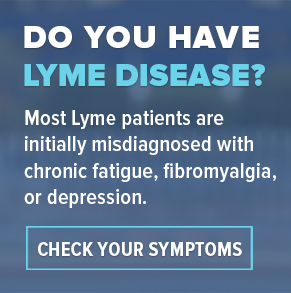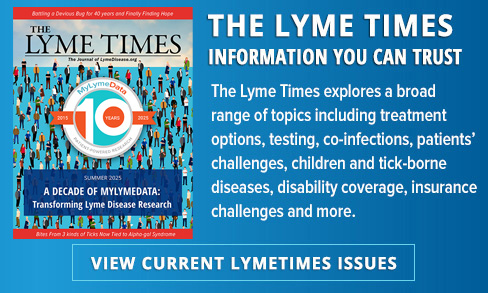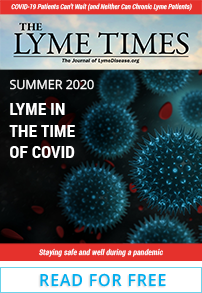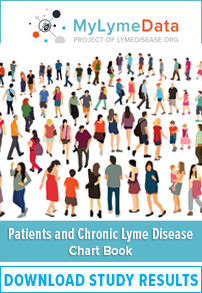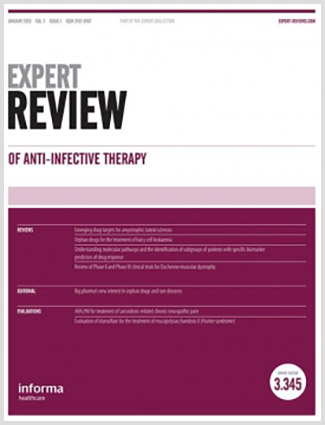Expert Review of Anti-infective Therapy — Sexual transmission of Lyme disease: challenging the tickborne disease paradigm.
Lyme disease is the most common tickborne illness in the world today 1,2. It is also one of the most controversial illnesses in the history of medicine, and the controversy features two opposing camps. One camp espouses the viewpoint of the International Lyme and Associated Diseases Society (ILADS) that tickborne infection with the Lyme spirochete, Borrelia burgdorferi, can be difficult to detect given the current state of diagnostic tests and that the organism can be hard to eradicate given its ability to evade the host immune response and antibiotic therapy 1,2. The other camp espouses the viewpoint of the Infectious Diseases Society of America (IDSA) that Lyme disease is a simple tickborne infection that is easily diagnosed and treated. According to this viewpoint, the notion that infection may persist after a short course of antibiotics lacks ‘credible scientific evidence’, persistence mechanisms of B. burgdorferi are deemed ‘implausible’ and chronic Lyme disease due to persistent B. burgdorferi infection is rare or non-existent 3,4. While the revised ILADS Lyme guidelines recommend longer antibiotic treatment for patients with chronic Lyme disease, the IDSA Lyme guidelines discourage antibiotic treatment for patients with persistent Lyme disease symptoms 5,6.
The Lyme disease controversy has resulted in a stalemate between the ILADS and IDSA points of view. Each side claims that its clinical, epidemiological, diagnostic and therapeutic pronouncements are ‘evidence based’ and represent the ‘standard of care’ for the disease. This ‘he said/she said’ dispute in turn has left patients without a clear path to diagnosis and treatment of the disease. The dispute has also dampened pharmaceutical company interest in developing new antibiotic treatments for the disease similar to the ‘designer drugs’ that have revolutionized the therapy of HIV/AIDS and hepatitis C virus (HCV) infection. The medical and lay press has also been confused by the dispute and ultimately has lost interest in publishing repetitive articles about a tickborne disease that could be characterized as unimportant 7,8.
Despite these issues, the specter of Lyme disease has continued to grow. In 2013, the CDC published a trio of reports suggesting that the annual rate of Lyme disease was more than 300,000 cases in the USA 9.
This annual rate was more than 10-times the number of cases reported using the surveillance case definition employed by the CDC, making Lyme disease almost twice as common as breast cancer and six-times more common than HIV/AIDS. The huge rate increase also created problems for the epidemiology of the tickborne disease. Based on a study of confirmed tickbites in the Netherlands, the annual tickbite rate was estimated to be 495 per 100,000 population, which translates into about 1.5 million tickbites per year in the USA 10. Based on the assumption that only 2% of tickbites yield infection with B. burgdorferi 10, it would take 15 million tickbites per year to achieve the CDC rate of Lyme disease. This implausible tickbite requirement suggests that other means of Lyme disease transmission may occur.
The Lyme spirochete B. burgdorferi is a relatively complex organism that is similar to the spirochetal agent of syphilis 1. B. burgdorferi contains enzymes that facilitate tissue penetration, and the spirochete has the ability to form cystic structures and hide in biofilms 11–15. These properties allow the organism to persist in a variety of tissues and hostile environments and to escape the reach of antibiotics. The ability of B. burgdorferi to infect privileged sites such as the eye, synovium and brain may also contribute to persistence of the spirochete in human tissues 1,2. The pleotropic and pleomorphic properties of the spirochete suggest that the genital tract could also harbor the infection, resulting in transmission from person to person without a tick vector.
Evidence for direct transmission of B. burgdorferi in the absence of a tick vector initially came from animal studies, although results were mixed. A mouse study by Burgess et al. demonstrated transmission of the spirochete from infected to uninfected animals of the same sex 16. Another mouse study by Wright and Nielsen demonstrated B. burgdorferi transmission from infected males to uninfected females following intercourse 17. A third mouse study by Altaie et al. demonstrated spirochetal transmission from infected males to their offspring, presumably via maternal contact transmission 18. An unpublished study by Gustafson showed transmission of the Lyme spirochete to uninfected female dogs and their offspring via artificial insemination with infected semen 19. In contrast, studies in Lewis rats and Syrian hamsters failed to show contact or sexual transmission in these highly inbred rodents. Limited contact times and lack of PCR testing may have contributed to the negative results in these two animal models 20,21. Of interest, B. burgdorferi transmission has also been associated with sexual contact between male and female Ixodes ticks 22.
Human sexual transmission of Lyme disease was initially suggested by Bach in 2001 23. He observed that sexually active patients had a marked propensity for antibiotic failure and speculated that re-infection occurred by intimate person-to-person contact. In 2003, Harvey and Salvato studied a group of chronically ill B. burgdorferi-seropositive and PCR-positive patients in Houston, Texas – a non-endemic area – and provided epidemiological evidence that Lyme disease could spread in the absence of infected ticks. In this scenario, intimate person-to-person transfer was implicated as the probable means of transmission 24. A study by Stricker et al. provided clinical and immunological evidence for B. burgdorferi transmission via intimate contact. In heterosexual seropositive couples with Lyme disease in which only one partner had a documented tickbite, the partner with the documented tickbite tended to have more severe clinical manifestations of the disease and a lower CD57 NK cell level. This difference in clinical severity and CD57 NK cell level was not noted in seropositive couples diagnosed with Lyme disease in which both partners had a documented history of tickbite 25. Sexual transfer of B. burgdorferi infection therefore seems possible in humans.
In order to investigate this possibility, Middelveen et al. performed the first Borrelia culture study on human semen and vaginal secretions 26. Patients with documented Lyme disease, including heterosexual couples having unprotected sex, had genital cultures studied in three independent laboratories. The cultures of semen and vaginal secretions were subjected to light and darkfield microscopy and were found to contain live, motile spirochetes that displayed characteristic undulating movement and stained positive with Dieterle silver staining and anti-B. burgdorferi immunostaining. Furthermore, PCR testing and molecular hybridization with highly specific DNA probes demonstrated that the live genital spirochetes were Borrelia strains and not treponemes. Of particular interest, one couple was found to have B. hermsii rather than B. burgdorferi in their genital secretions, further implicating sexual transmission in these cases. Control subjects who tested negative for Lyme disease had no evidence of Borrelia spirochetes in their genital secretions 26.
The combination of animal models and human studies strongly suggests that the Lyme spirochete may be sexually transmitted, much like the spirochetal agent of syphilis. This possibility is difficult to prove because direct transmission studies in humans similar to the ‘volunteer’ experiments performed on syphilis patients 27 would be unethical by current standards. However, the animal studies showing contact and sexual transmission should be reproduced and extended to other animal models using sophisticated immunological and molecular methods to examine venereal exposure to B. burgdorferi. In addition, further epidemiology studies should be conducted to assess whether sexual transmission might explain the increase in Lyme disease cases around the world. These studies could also address geographical discrepancies between human and tick infection rates in various reports as well as gender discrepancies in Lyme disease statistics 28–30. The results might create a paradigm shift that would transform Lyme disease from a tickborne illness into a sexually transmitted infection.
The significance of this paradigm shift would be profound. As a sexually transmitted infection, Lyme disease would command greater respect in the medical community. The current inadequate diagnostic tests for the disease would have to be replaced with more sensitive testing, and test patterns would have to be adjusted to account for sexual transmission. Treatment for Lyme disease would also need to be reassessed, with therapeutic approaches tailored to eradication of the spirochete from privileged sites in the genital tract similar to the tactics for treating HIV/AIDS 31,32. Pharmaceutical companies would be encouraged to come up with new ‘designer drugs’ for this sexually transmitted disease using the strategies that produced effective treatments for HIV/AIDS and HCV. The Lyme disease landscape would change drastically for patients. Although infected individuals would be forced to deal with the risk of sexual transmission, they would also benefit from easier access to treatment and eventually better treatment based on the experience with HIV/AIDS and HCV. With this paradigm shift, the ‘Lyme Wars’ would finally come to an end, and after more than 40 years the Lyme spirochete could finally be contained.
Acknowledgments
The authors thank S Altaie, A Barbour, G Chaconas, L Gilbert, N Haak, M Kroun, R Lane, SH Lee, K Liegner, A MacDonald, L Montagnier, K Mullis, E Sapi, J Shah and J Sperling for helpful discussion. They also thank L Johnson, P Mervine and P Smith for online support.
Financial & competing interests disclosure
The authors are supported in part by a grant from the Lindorf Family Foundation, Newark, OH. The authors have no other relevant affiliations or financial involvement with any organization or entity with a financial interest in or financial conflict with the subject matter or materials discussed in the manuscript apart from those disclosed.
- Stricker RB, Johnson L. Lyme disease: the next decade. Infect Drug Resist 2011;4:1-9
- Stricker RB, Johnson L. Lyme disease diagnosis and treatment: Lessons from the AIDS epidemic. Minerva Med 2010;101:419-25
- Feder HMJr, Johnson BJ, O’Connell S, et al. A critical appraisal of ‘chronic Lyme disease’. N Engl J Med 2007;357:1422-30
- Tuttle C. Lyme disease antiscience. Lancet Infect Dis 2012;12:362
- Cameron DJ, Johnson LB, Maloney EL. Evidence assessments and guideline recommendations in Lyme disease: the clinical management of known tick bites, erythema migrans rashes and persistent disease. Expert Rev Anti Infect Ther 2014;12:1103-35
- Wormser GP, Dattwyler RJ, Shapiro ED, et al. The clinical assessment, treatment, and prevention of Lyme disease, Human Granulocytic Anaplasmosis, and Babesiosis: Clinical practice guidelines by the Infectious Diseases Society of America. Clin Infect Dis 2006;41:1089-134
- Stricker RB, Johnson L. The pain of chronic Lyme disease: moving the discourse backward? FASEB J 2011;25:4085-7
- Kullberg BJ, Berende A, van der Meer JW. The challenge of Lyme disease: tired of the Lyme wars. Neth J Med 2011;69:98-100
- CDC 2013. Press Release: CDC provides estimate of americans diagnosed with lyme disease each year. August 19, 2013. Available from: www.cdc.gov/media/releases/2013/p0819-lyme-disease.html[Last accessed 18 April 2015]
- Hofhuis A, Harms M, Bennema S, et al. Physician reported incidence of early and late Lyme borreliosis. Parasit Vectors 2015;8:161
- Brorson Ø, Brorson SH. Transformation of cystic forms of Borrelia burgdorferi to normal mobile spirochetes. Infection 1997;25:240-6
- Murgia R, Cinco M. Induction of cystic forms by different stress conditions in Borrelia burgdorferi. APMIS 2004;112:57-62
- MacDonald AB. Borrelia burgdorferi tissue morphologies and imaging methodologies. Eur J Clin Microbiol Infect Dis 2013;32:1077-82
- Stricker RB, Johnson L. Borrelia burgdorferi aggrecanase activity: more evidence for persistent infection in Lyme disease. Front Cell Infect Microbiol 2013;3:40
- Meriläinen L, Herranen A, Schwarzbach A, Gilbert L. Morphological and biochemical features of Borrelia burgdorferi pleomorphic forms. Microbiology 2015;161(Pt 3):516-27
- Burgess EC, Amundson TE, Davis JP, et al. Experimental inoculation of Peromyscus spp. with Borrelia burgdorferi: Evidence of contact transmission. Am J Trop Med Hyg 1986;35:355-9
- Wright SD, Nielsen SW. Experimental infection of the white-footed mouse with Borrelia burgdorferi. Am J Vet Res 1990;51:1980-7
- Altaie SS, Mookherjee S, Assian E, et al. Transmission of Borrelia burgdorferi from experimentally infected mating pairs to offspring in a murine model. FDA Science Forum 1996. Abstract # I-17. Available from: http://sci.tech-archive.net/Archive/sci.med.diseases.lyme/2005-01/0901.html [Last accessed 11 July 2015]
- Gustafson JM. The in utero and seminal transmission of Borrelia burgdorferi in Canidae. 1993. PhD thesis, University of Wisconsin, Madison. Available from: http://search.library.wisc.edu/catalog/ocm29551629 [Last accessed 18 April 2015]
- Moody KD, Barthold SW. Relative infectivity of Borrelia burgdorferi in Lewis rats by various routes of inoculation. Am J Trop Med Hyg 1991;44:135-9
- Woodrum JE, Oliver JH. Investigation of venereal, transplacental, and contact transmission of the Lyme disease spirochete, Borrelia burgdorferi, in Syrian hamsters. J Parasitol 1999;85:426-30
- Alekseev AN, Dubinina HV. Exchange of Borrelia burgdorferi between Ixodes persulcatus (Ixodidae: Acarina) sexual partners. J Med Entomol 1996;33:351-4
- Bach G. Recovery of Lyme spirochetes by PCR in semen samples of previously diagnosed Lyme disease patients. International Scientific Conference on Lyme Disease. 2001. Available from: www.anapsid.org/lyme/bach.html [Last accessed 18 April 2015]
- Harvey WT, Salvato P. ’Lyme disease’: ancient engine of an unrecognized borreliosis pandemic? Med Hypotheses 2003;60:742-59
- Stricker RB, Moore DH, Winger EE. Clinical and immunologic evidence for transmission of Lyme disease through intimate human contact. J Investig Med 2004;52:S151
- Middelveen MJ, Burke J, Sapi E, et al. Culture and identification of Borrelia spirochetes in human vaginal and seminal secretions. F1000Research 2015;3:309
- Lafond RE, Lukehart SA. Biological basis for syphilis. Clin Microbiol Rev 2006;19:29-49
- Mayne PJ. Clinical determinants of Lyme borreliosis, babesiosis, bartonellosis, anaplasmosis and ehrlichiosis in an Australian cohort. Int J Gen Med 2015;8:1-12
- Rossi C, Stromdahl EY, Rohrbeck P, et al. Characterizing the relationship between tick bites and Lyme disease in active component U.S. Armed Forces in the eastern United States. MSMR 2015;22:2-10
- Stricker RB, Johnson L. Lyme disease: Call for a “Manhattan Project” to combat the epidemic. PLoS Pathog 2014;10:e1003796
- Coombs RW, Reichelderfer PS, Landay AL. Recent observations on HIV type-1 infection in the genital tract of men and women. AIDS 2003;17:455-80
- Cu-Uvin S, DeLong AK, Venkatesh KK, et al. Genital tract HIV-1 RNA shedding among women with below detectable plasma viral load. AIDS 2010;24:2489-97
Expert Review of Anti-infective Therapy A MEDLINE-indexed journal delivering the latest research, publishing a variety of articles on all aspects involved in the treatment and management of infectious disease. This journal offers accelerated publication.


